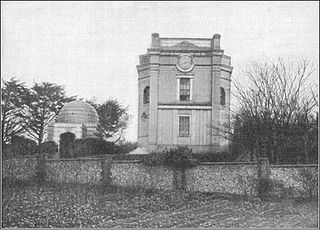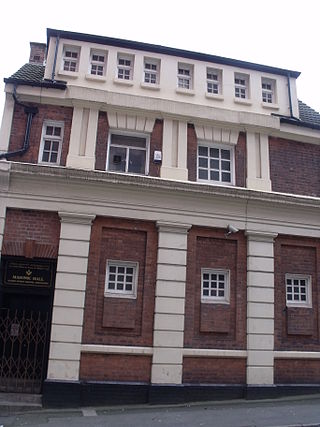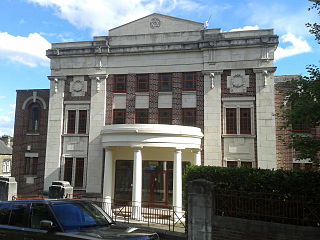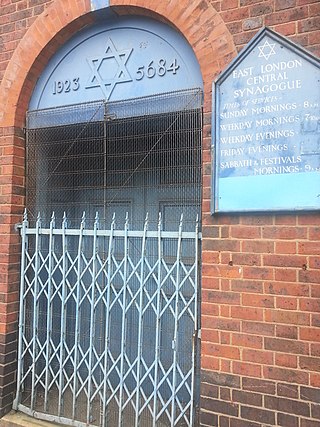
A synagogue, also called a shul or a temple, is a place of worship for Jews and Samaritans. It has a place for prayer where Jews attend religious services or special ceremonies such as weddings, bar and bat mitzvahs, choir performances, and children's plays. They also have rooms for study, social halls, administrative and charitable offices, classrooms for religious and Hebrew studies, and many places to sit and congregate. They often display commemorative, historic, or modern artwork alongside items of Jewish historical significance or history about the synagogue itself.

Princes Road Synagogue is a synagogue on Princes Road in the Toxteth district of Liverpool, England. It is the home of the Liverpool Old Hebrew Congregation. It was founded in the late 1860s, designed by William James Audsley and George Ashdown Audsley, and consecrated on 2 September 1874. It is widely regarded as the finest example of the Moorish Revival style of synagogue architecture in the UK, and synagogues emulating its design can be found as far away as Sydney.

Synagogue architecture often follows styles in vogue at the place and time of construction. There is no set blueprint for synagogues and the architectural shapes and interior designs of synagogues vary greatly. According to tradition, the Shekhinah or divine presence can be found wherever there is a minyan, a quorum, of ten. A synagogue always contains an Torah ark where the Torah scrolls are kept, called the aron qodesh by Ashkenazi Jews and the hekhal by Sephardic Jews.
The name South Manchester Synagogue refers to both an Orthodox Jewish community in south Manchester, England and to the buildings that it occupies. In 2002, the community relocated from synagogue buildings in the Fallowfield district of Manchester to new premises in Bowdon, Altrincham, Greater Manchester.

The West London Synagogue, abbreviated WLS, and fully the West London Synagogue of British Jews is a Reform Jewish congregation and synagogue, located near Marble Arch, at 34 Upper Berkeley Street, in the City of Westminster, in Central London, England, in the United Kingdom.

The Singers Hill Synagogue, officially the Birmingham Hebrew Congregation, is an Orthodox Jewish congregation and synagogue, located at 26, 26A and 26B Blucher Street, in the Birmingham city centre, in the West Midlands of England, in the United Kingdom. The congregation dates from 1780 and worshiped in the Ashkenazi rite.

The Great Synagogue of London was a former Orthodox Jewish congregation and synagogue, located in the City of London, England, in the United Kingdom. The synagogue was, for centuries, the centre of Ashkenazi life in London. Built north of Aldgate in the 17th century, it was destroyed during World War II, in the Blitz.

Brunswick Town is an area in Hove, in the city of Brighton and Hove, England. It is best known for the Regency architecture of the Brunswick estate.

Fieldgate Street Great Synagogue,, is a former Orthodox Jewish congregation and synagogue, located at 41 Fieldgate Street, Whitechapel, in the Borough of Tower Hamlets, in the East End of London, England, in the United Kingdom. Established in 1899, the congregation worshiped in the Ashkenazi rite. The synagogue building was sold in 2015 and it has since operated as a mosque.

TheGreat Synagogue is an Orthodox Jewish congregation located in a large heritage-listed synagogue at 187a Elizabeth Street in the Sydney central business district in the City of Sydney in New South Wales, Australia.

The Montefiore Synagogue is the former private synagogue of Sir Moses Montefiore. It is an 1833, Grade II* listed building in Ramsgate, Kent, England. The synagogue and mausoleum are cared for and maintained by the Montefiore Endowment. The endowment also maintains the nearby Ramsgate Jewish Cemetery.

The Włodawa Synagogue in Włodawa, Poland is an architectural complex consisting of two historic synagogues and a Jewish administrative building, now preserved as a museum. The complex includes the Włodawa Great Synagogue of 1764–74, the late 18th century Small Synagogue, and the 1928 community building. It is "one of the best-preserved" synagogues in Poland.

The Wilson, formerly known as Cheltenham Art Gallery and Museum, in Cheltenham, Gloucestershire, was opened in 1899. It offers free admission, and has a programme of special exhibitions. It was renamed The Wilson in honour of polar explorer Edward Wilson, a son of Cheltenham, in 2013 after the building was extended. The gallery and museum is managed by The Cheltenham Trust.

The Severn Street Synagogue is a former Orthodox Jewish congregation and synagogue, located at 60 Severn Street, Birmingham, West Midlands, England, in the United Kingdom. The congregation was founded in 1809 and worshiped in the Ashkenazi rite until the congregation was merged into the Singers Hill Synagogue congregation in 1856.
West Ham Jewish Cemetery is a cemetery for Jews in West Ham in the London Borough of Newham, England. It was established in 1856 by the New Synagogue on Great St. Helen's, soon joined by the Great Synagogue in Duke's Place, both of them London congregations. It has been closed to new burials since 2002

The Brunswick Terrace Synagogue, also sometimes called the Roof-top synagogue, was a private Orthodox Jewish synagogue that was built on the roof-top of 26 Brunswick Terrace, a terraced-row of houses on the Brunswick Estate in Hove, now a constituent part of the city of Brighton and Hove, in East Sussex, England, in the United Kingdom.

There are 72 Grade II* listed buildings in the city of Brighton and Hove, England. The city, on the English Channel coast approximately 52 miles (84 km) south of London, was formed as a unitary authority in 1997 by the merger of the neighbouring towns of Brighton and Hove. Queen Elizabeth II granted city status in 2000.

The Wilson Road Synagogue is a former Orthodox Jewish congregation and synagogue, located at 11 Wilson Road, Ecclesall, Sheffield, England, in the United Kingdom. The congregation was formed in 1914 and worshiped in the Ashkenazi rite until the congregation was dissolved in 1997.

The East London Central Synagogue is an Orthodox Jewish congregation synagogue, located on Nelson Street in the East End of the City of London, England, in the United Kingdom. When founded in 1923, its name was the Nelson Street Sfardish Synagogue. It has "an unassuming exterior and a stunningly beautiful interior". The congregation worships in the Ashkenazi rite.

















